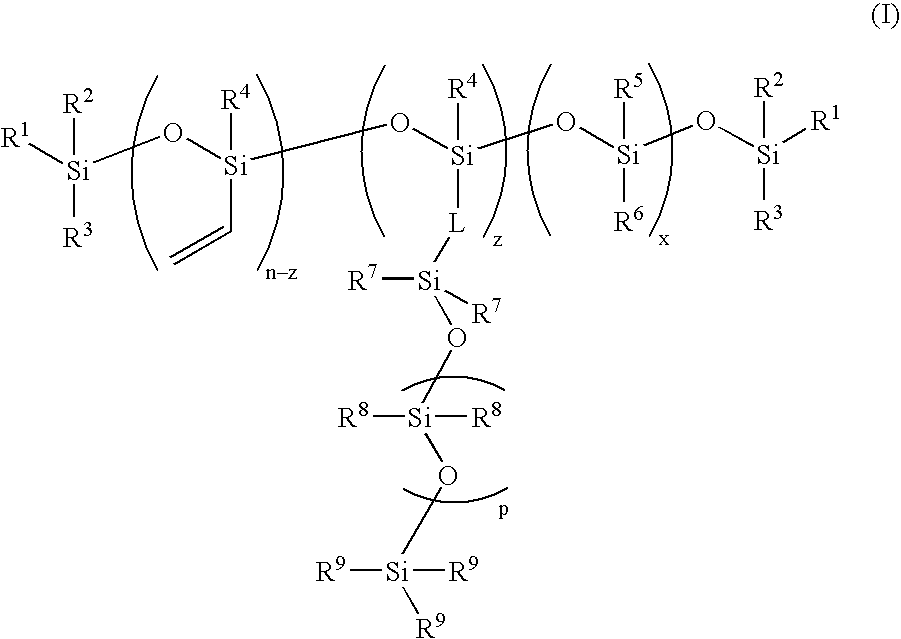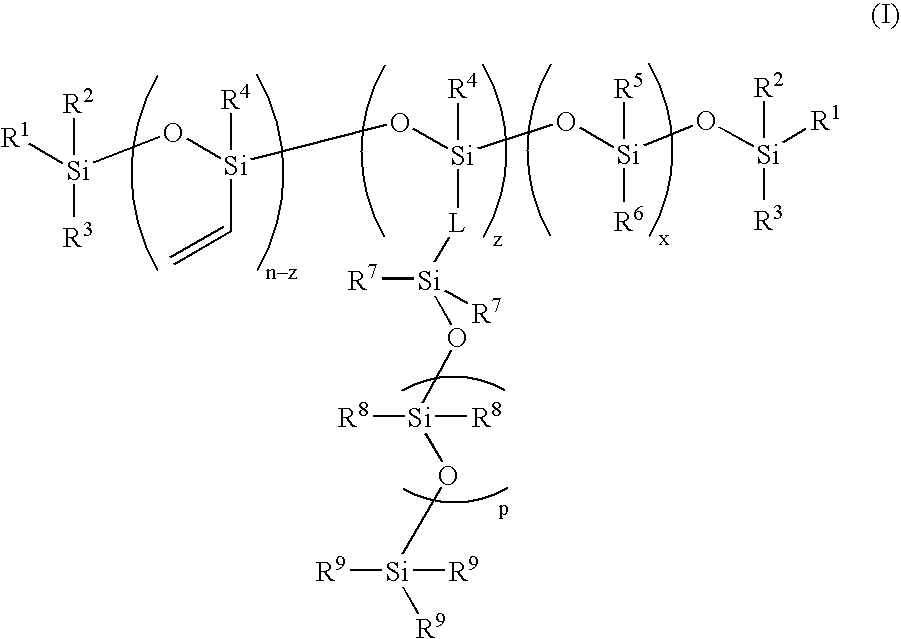High refractive-index siloxy-containing monomers and polymers, and ophthalmic devices comprising such polymers
a technology of macromonomers and polymers, which is applied in the field of high refractive index siloxycontaining monomers, macromonomers, polymers, and ophthalmic devices comprising such polymers, can solve the problems of less popularization of more rigid iol implants in the market, increased postoperative incidence, and less desirable than other materials with respect to minimal incision siz
- Summary
- Abstract
- Description
- Claims
- Application Information
AI Technical Summary
Benefits of technology
Problems solved by technology
Method used
Image
Examples
example 1
Preparation of Divinyl-Terminated Poly(dimethylsiloxane-co-methylvinylsiloxane)
[0060] A three-neck, 500 ml round bottom flask connected with a reflux condenser and nitrogen purge inlet tube is charged with 1,1,3,3,5,5,7,7-octamethylcyclotetrasiloxane; 1,3,5,7-tetramethyl-1,3,5,7-tetravinylcyclotetrasiloxane; 1,3-divinyltetramethyldisiloxane; and a small amount of aminosilanoate as catalyst (from Gelest, Inc., Morrisville, Pa.). The relative amounts of 1,1,3,3,5,5,7,7-octamethyltetrasiloxane and 1,3,5,7-tetramethyl-1,3,5,7-tetravinylsiloxane are chosen to achieve the desired ratio of the dimethylsiloxy units to the methylvinylsiloxy units. The contents are stirred under nitrogen and heated with an oil bath at 80-90° C. After 16 hours, the contents are heated to 140° C. to decompose the aminosilanoate catalyst to yield the divinyl-terminated poly(dimethylsiloxane-co-methylvinylsiloxane).
example 2
Preparation of 1,1-dimethyl-3,3,3-triphenyldisiloxane
[0061] A three-neck, 500 ml round bottom flask connected with a reflux condenser and nitrogen purge inlet tube is charged under nitrogen purge with equal molar amounts of dimethylchlorosilane and triphenylsilanol (from Gelest, Inc., Morrisville, Pa.). The contents are stirred under nitrogen and heated with an oil bath at 80-90° C. for 2 hours to produce 1,1-dimethyl-3,3,3-triphenyldisiloxane.
example 3
Preparation of Divinyl-Terminated Poly(dimethylsiloxane-co-methylvinylsiloxane) Under an Alternate Reaction Condition as Compared to Example 1
[0062] A three-neck, 500 ml round bottom flask connected with a reflux condenser and nitrogen purge inlet tube is charged with 1,1,3,3,5,5,7,7-octamethylcyclotetrasiloxane; 1,3,5,7-tetramethyl-1,3,5,7-tetravinylcyclotetrasiloxane; 1,3-divinyltetramethyldisiloxane; and a small amount of triflic acid (less than about 0.5 weight percent, preferably less than about 0.25 weight percent). The contents are stirred under nitrogen for 16 hours. To contents is then added an amount of about 200 ml of ether. The contents are then washed with 100 ml of 0.05 N of sodium hydroxide and then with 100 ml of water to bring the pH to 7. The contents are then dried with magnesium sulfate and filtered. The ether solution is vacuum stripped at room temperature to give the product of divinyl-terminated poly(dimethylsiloxane-co-methylvinylsiloxane).
PUM
| Property | Measurement | Unit |
|---|---|---|
| refractive index | aaaaa | aaaaa |
| refractive index | aaaaa | aaaaa |
| refractive index | aaaaa | aaaaa |
Abstract
Description
Claims
Application Information
 Login to View More
Login to View More - R&D
- Intellectual Property
- Life Sciences
- Materials
- Tech Scout
- Unparalleled Data Quality
- Higher Quality Content
- 60% Fewer Hallucinations
Browse by: Latest US Patents, China's latest patents, Technical Efficacy Thesaurus, Application Domain, Technology Topic, Popular Technical Reports.
© 2025 PatSnap. All rights reserved.Legal|Privacy policy|Modern Slavery Act Transparency Statement|Sitemap|About US| Contact US: help@patsnap.com



